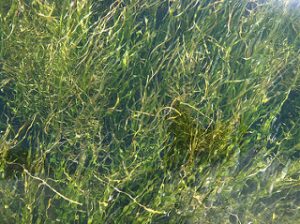 The Maryland Department of Natural Resources reported today that underwater grass abundance – a key indicator of improving water clarity and quality – increased for the fourth straight year in the state’s portion of the Chesapeake Bay, reaching a record of 59,277 acres.
The Maryland Department of Natural Resources reported today that underwater grass abundance – a key indicator of improving water clarity and quality – increased for the fourth straight year in the state’s portion of the Chesapeake Bay, reaching a record of 59,277 acres.
This represents a 10 percent increase from 2015, and also surpasses Maryland’s 2017 restoration goal of 57,000 acres one year ahead of schedule.
“These underwater grasses are essential to a healthy and sustainable ecosystem,” Natural Resources Secretary Mark Belton said. “It’s encouraging that Maryland is exceeding our Chesapeake Bay restoration goals and continuing to measure improved water quality throughout the watershed.”
Also known as submerged aquatic vegetation or SAV, underwater grasses absorb and filter out nutrients and sediment, reduce shoreline erosion, provide habitat and protection for species like the blue crab and largemouth bass, and support and sustain migrating waterfowl.
In Maryland, all or part of 10 rivers surpassed their restoration goals:
- Big Annemessex River at 169 percent;
- Chesapeake and Delaware Canal at 305 percent;
- Chester River (brackish portion) at 132 percent;
- Chester River (tidal fresh portion) at 35,833 percent;
- Elk River at 199 percent;
- Fishing Bay at 158 percent;
- Gunpowder River at 128 percent;
- Honga River at 101 percent;
- Manokin River at 181 percent;
- Middle River at 108 percent; and
- Northeast River at 101 percent.
An additional six segments reached 75 percent or more of their restoration goals.
The rise in underwater grasses is attributed to an expansion of widgeon grass – characterized by scientists as a boom-or-bust plant – in portions of the midbay region, and to a variety of freshwater grasses, like wild celery that grow in the upper and fresher portions of the bay.
Maryland’s biggest and most iconic underwater grass bed, located in the Susquehanna Flats, has been steadily recovering since 2012, and reached more than 5,900 acres in 2016, showcasing the bed’s continued resilience.
Water monitoring results for the Eastern Shore indicate long-term improvements in clarity as a result of reduced nutrients and sediments. Bay grasses in this region responded to the improving water conditions for the fourth year in a row and are continuing to provide increased habitat for aquatic species like the blue crab.
The annual underwater grass aerial survey was conducted by the Virginia Institute of Marine Science between May and November 2016. Air space restrictions and weather prevented complete surveys of the Upper and Lower Potomac River, including Piscataway Creek. If these areas had been fully mapped, observations suggest that Maryland’s acreage would have been even higher in 2016.


